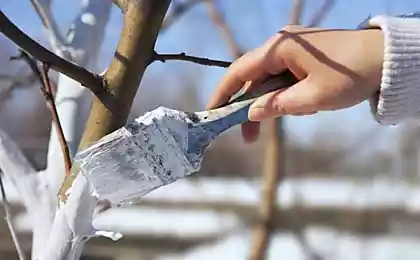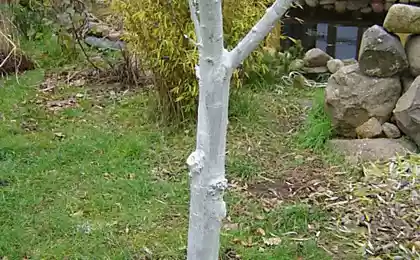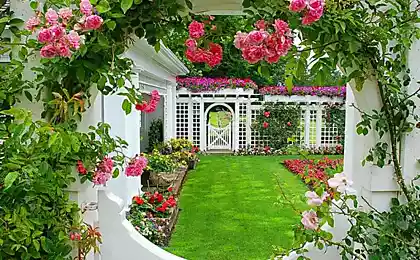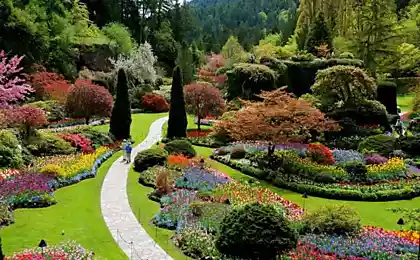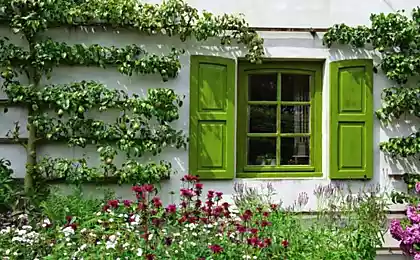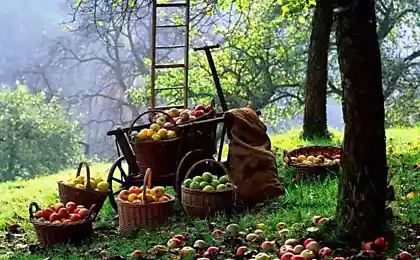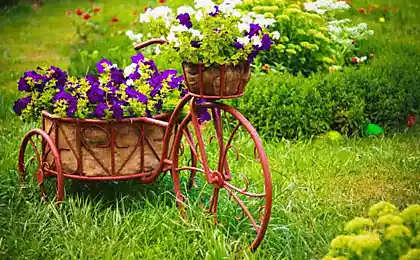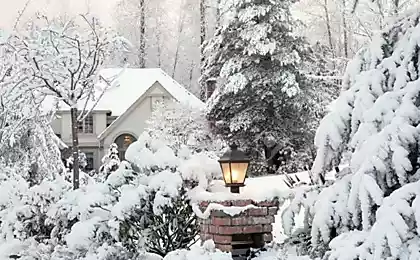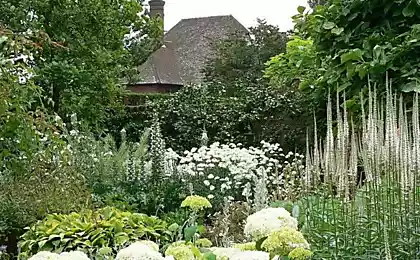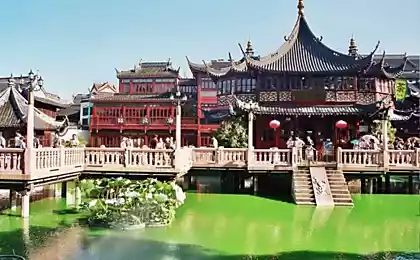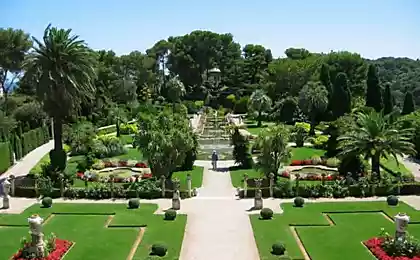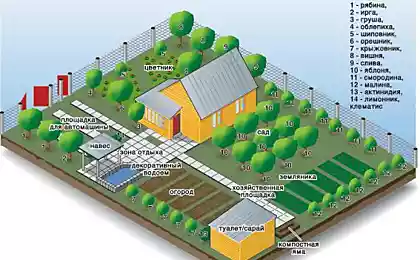613
How to whitewash the trees in the garden
Autumn was marked by the falling leaves and the first snow, and gusts of cold wind with "anticreative" a clatter of plastic bottles on the deserted suburban areas. Only here the cheerful clink of buckets in which to mix the lime in our area again is not audible. Again, mass whitewashing of fruit trees is transferred to the spring. Which is a pity. Ahead of the wind and ice, Sunny and frosty days, the invasion of rodents and hibernating in the bark pests. But the trees remain for the winter without a protective suit lime...
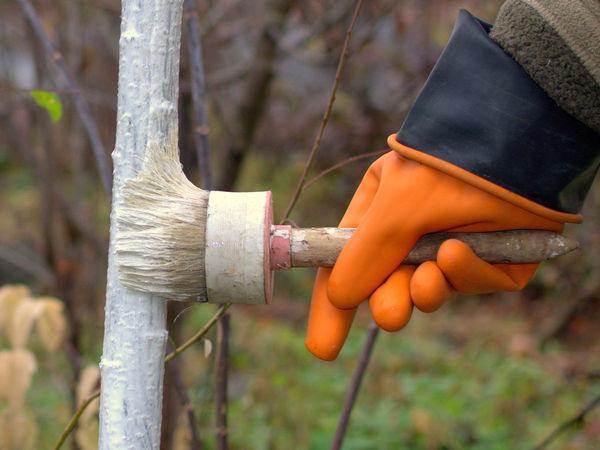
Whitewashing is not just a fad. Is part of the important agrotechnical reception of care for the crust. But the sense of it is only if the barrel is correctly prepared. The whole process consists of 4 successive stages: cleaning, disinfection crust, sealing of wounds and the whitewash.
Phase I: cleaning the barrel On many adults, especially on old trunks and bases of skeletal branches of the lower settled mosses and lichens. The bark cracked and flaking. All that you need to clean off. Experienced gardeners there are special tools, but you can do improvised means.
The best way to clean the face: hands in fabric gloves, or homemade "sponge" of plastic twine, folded in several layers.
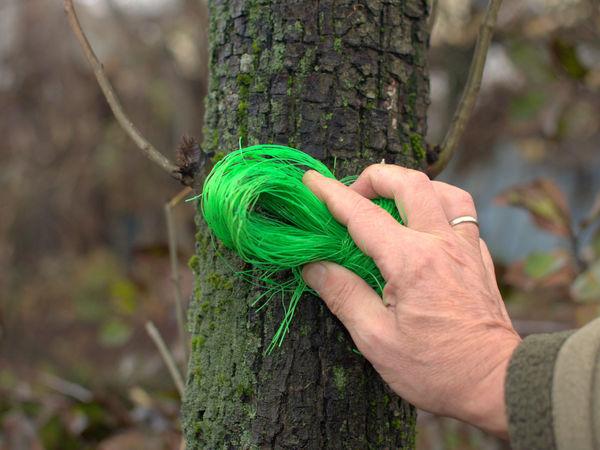
Cleaning is carried out in wet weather. Cracks and deepening of the treated wood with a knife or even a pointed sliver, so as not to injure the trunk. Proponents of this approach strongly against metal brushes, scrapers and sponges. And even more so against cleaning a hoe or a saw blade, which can severely injure the tree. Other growers used them for years and consider it the norm. You choose, the main thing — to observe the principle of "do No harm".
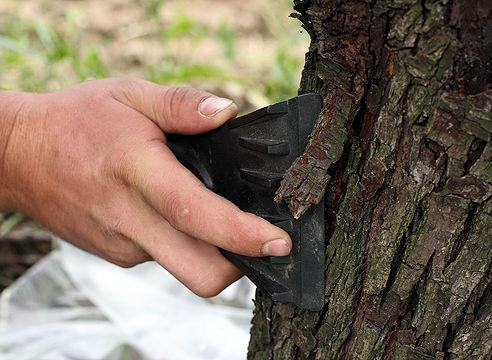
In any case, before cleaning the barrel should be spread under the tree oilcloth or thick fabric. On it fall cleaning off the moss, lichens, bark pieces and the contents of the cracks, where they found winter shelter for pests. All this should be attributed away from trees and burned.
But the practical tutorial for the care of the trunks of fruit trees:
Phase II: disinfection After cleaning of the trunk be sure to disinfect all cleaned surfaces and places where there are wounds and cracks. What does it do?
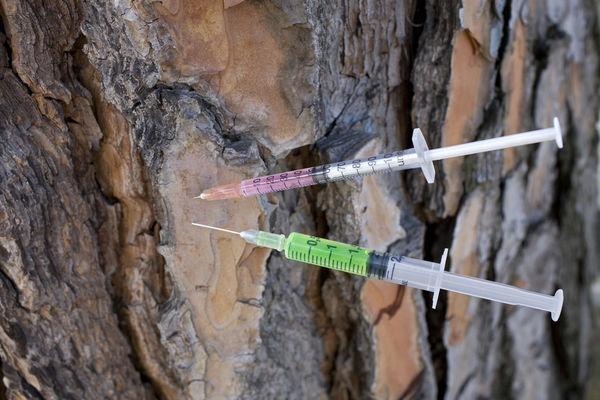
Than to be disinfected, There are several national and chemical methods that are successfully used by experienced gardeners. Consider the most common and inexpensive.
Ash (ash-soap) infusion
2.5-3 kg sieved ash diluted in 10 liters of hot water and add 50-60 g of soap for adhesion. To wash the trunk and branches when the liquid is still warm (well, if her temperature is above +40 ° C).
Ash lye
Thoroughly mix 2.5-3 kg sieved ash in 10 l of water, bring to the boil and leave to cool. All the liquid above the sediment is ash lye. For spraying the trunks and branches it is diluted in the ratio 1:1 or 1:2.
Copper-containing drugs
A solution of iron sulphate
Iron sulfate can be used at a concentration of 3-5% or 6-8%. To do this, dissolve 300-500 g of iron sulphate (or 600-800 g, respectively) in 10 l of water
Attention! Although chemical drugs are effective, use them every year still not worth it. And copper, and iron do not disappear. They safely accumulate in the bark and in the soil, where sediments are washed away, and in the end, reaching the "desired concentration", will be poison for the tree and for us.
Phase III: processing (smearing) of wounds After cleaning the barrel all the wounds of the tree — "like a palm". Each one is a magnet for all sorts of infections and must be treated with special ointment for reliable protection.
Than patch up the wounds Gardeners use many different composition of "putty": clay mash, garden var, pasta and biomask. You can buy them in specialized stores.
Garden var
Is used for healing wounds and protect the tree from drying out, exposure to rain and infection.
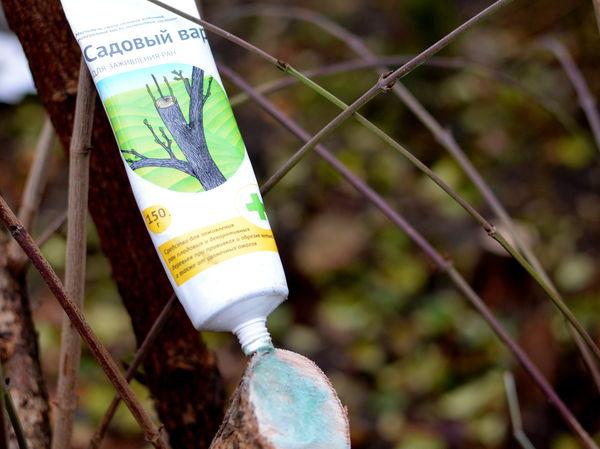
The finished pasta and biomasy
This special putty to protect trees from adverse weather conditions and pests.
The paste-plaster for disinfecting and healing wounds of the tree. It is composed of copper sulphate and HUMATE. So you can do without pre-treatment of copper-containing compounds. This paste is more convenient than homemade Vars: it ready-to-eat, perfectly and perfectly fits.
The following video tutorial silver biomasy Robin Green for the treatment of wounds, prevention and protection of wood
Phase IV: the actual whitewashing, Cleaning, disinfection and smearing the wounds behind. Left "cosmetic" part of caring for the tree whitewash. It is important to answer 3 questions: What are the compositions doing? What tools? How high?
Properly selected chemical composition of the mixture, method and height of whitewash — not trivial, but vital for the tree moments. "Beautiful — ugly, like — dislike" is our human category, and the tree needs protection.
The types pobelochnye mixtures of Trees are whitewashed with lime mortar, latex or aqueous dispersion paint.
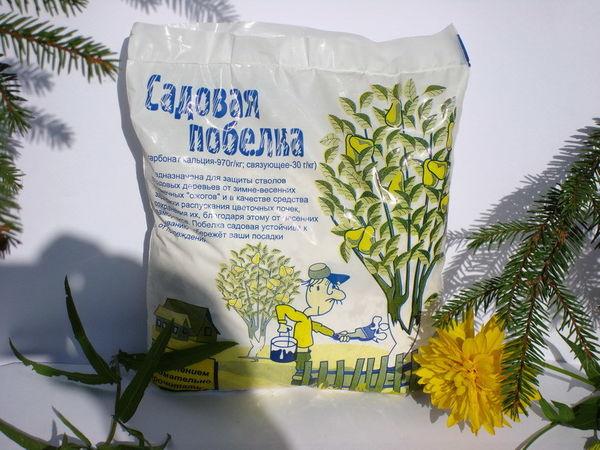
Lime mortars
Any pobelochnye composition should be 3 main components: chalk or Lime for white; Clay, soap, glue, etc. for adhesion; Copper sulphate, etc. for disinfection. Lime mortar, for whitewashing of trees gardeners use since time immemorial. The protective qualities of such compositions low. Besides, they quickly washed off by rains. But due to the simplicity and affordable price this option is still one of the most popular. "No good deed goes unpunished," the grumbling elders, incredulously looking at the purchase of paint and biomask)
Water-based and water-dispersion paints
Young gardeners, unlike fathers and grandfathers, is much more popular than the finished covering compositions.
These include water-based garden paint (not to be confused with painting! on the right there is a mark "garden trees"). As promised, you have a durable and totally safe for wood. It forms on wood a vapor permeable "breathable" coating, which is resistant to direct sunlight and water.

Popular and "Paint garden water dispersion for trees". It contains latex, pigment, antiseptic and modifying additives. Held up fine: on the young trees a year, and in adults up to 2 years.
The water based paints need to whiten only at zero temperature (preferably not lower than +7 °C, the minimum +3 °C). The drying time of a paint — approximately 1 hour "to touch" and a day to dry completely. The obtained layer is thinner than in whitewash lime mortar, but lasts much longer.
Than whitewash For whitewash large trees we have long used special brushes made from washcloths. But in recent years, gardeners are increasingly using either a synthetic brush of the same shape, or painting a centrifugal or ceiling brushes. These brushes are comfortable to work, they quickly and equally well probailout and smooth, and the rough surface of tree trunks.
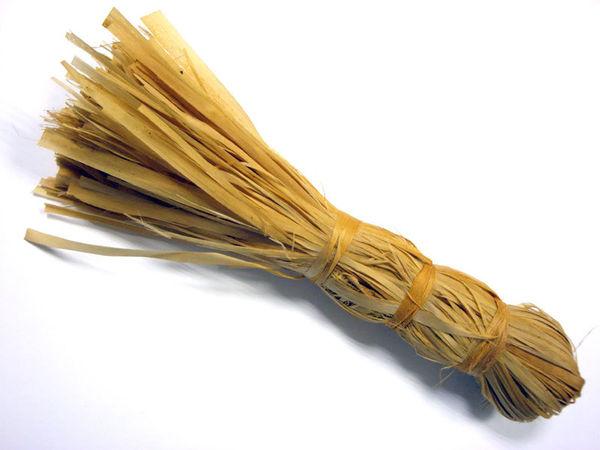
And young trees it is convenient to whiten the flat hammers finishing a brush. A little longer than round, but the expense of whitewashing less.
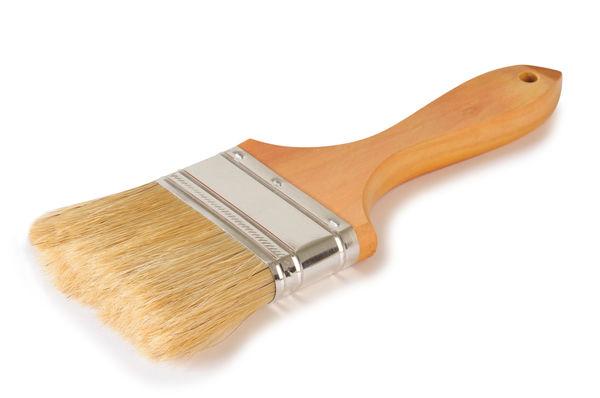
By the way, our gardeners are great inventors and innovators. They came up with to whitewash the old large trees with a rough bark, linked with 3-4 flat brushes , convenient and provalivaetsja great.
Some gardeners like to wash the paint rollers. What is linoversace coat cope well with uneven surfaces, and the speed increases.
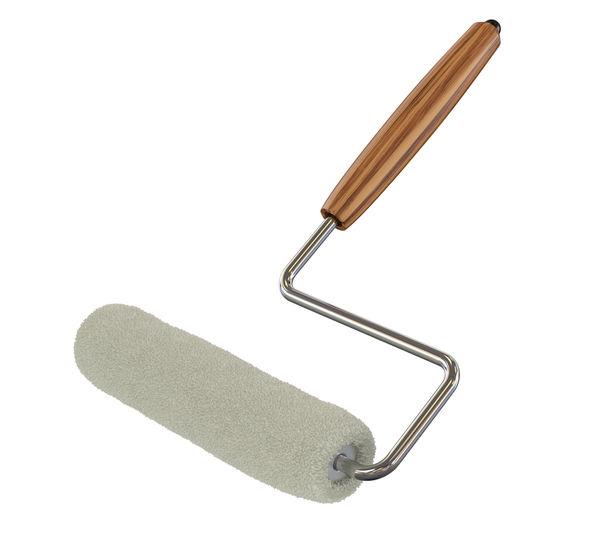
If the trees in the garden a lot, and they are adults, no brush, no roller, there is not nameless. In this case, the most effective method — wash spray gun-spray gun. And preferably in two layers.
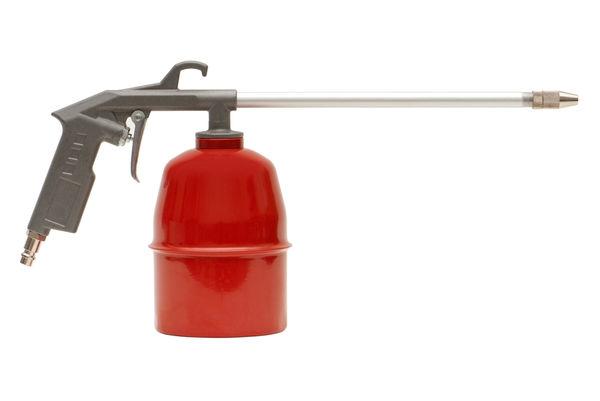
Regardless of the tools, whitewash the trees is necessary only in dry weather. Then the plaster is well dry and will be resistant to precipitation.
The height of a whitewash On what height to whitewash the trees in the garden — the question is not idle. The most common "urban" way — on the same height of 1-1,2 meters — it is purely for beauty. The benefits of such whitewash a little: monotony illiterate and about height restrictions do not read.
Conventionally considered sufficient whitewashing of the tree according to the following formula: all trunks + 1/3 the length of the lower skeletal branches. For adult trees (again averaged effective) pobelochnye height is considered to be 1.5-1.8 m, and experienced growers generally try their Pets whitewash as high as possible — up to 2 meters or more.
Not uncommon already, and garden plots, where fruit trees adorn the white lime attire to the tops. It turns out, as in sports — to win those who whitewash higher, stronger and whiter.
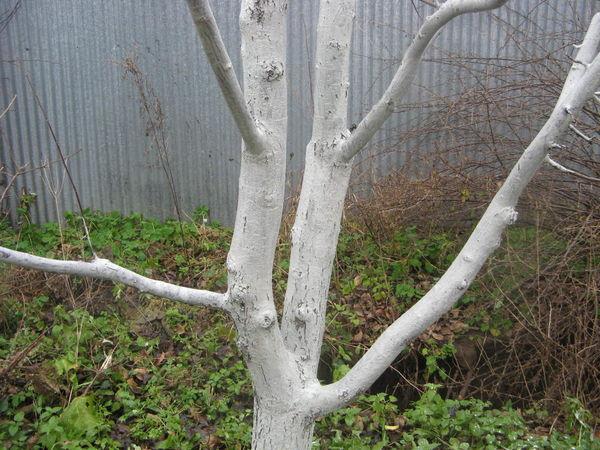
And in this video Mr Krylovich shares his long-tested recipe and method of whitewash
If your trees are still standing sad and neglected, we hope this material will convince you in a Sunny clear day to get out of town with a supply of brushes, garden pitch and a bucket of lime. The joy of the garden, which will definitely repay you in the same coin — the cool greenery in hot summer days, beautiful blooms and a rich harvest.
Source: www.7dach.ru

Whitewashing is not just a fad. Is part of the important agrotechnical reception of care for the crust. But the sense of it is only if the barrel is correctly prepared. The whole process consists of 4 successive stages: cleaning, disinfection crust, sealing of wounds and the whitewash.
Phase I: cleaning the barrel On many adults, especially on old trunks and bases of skeletal branches of the lower settled mosses and lichens. The bark cracked and flaking. All that you need to clean off. Experienced gardeners there are special tools, but you can do improvised means.
The best way to clean the face: hands in fabric gloves, or homemade "sponge" of plastic twine, folded in several layers.

Cleaning is carried out in wet weather. Cracks and deepening of the treated wood with a knife or even a pointed sliver, so as not to injure the trunk. Proponents of this approach strongly against metal brushes, scrapers and sponges. And even more so against cleaning a hoe or a saw blade, which can severely injure the tree. Other growers used them for years and consider it the norm. You choose, the main thing — to observe the principle of "do No harm".

In any case, before cleaning the barrel should be spread under the tree oilcloth or thick fabric. On it fall cleaning off the moss, lichens, bark pieces and the contents of the cracks, where they found winter shelter for pests. All this should be attributed away from trees and burned.
But the practical tutorial for the care of the trunks of fruit trees:
Phase II: disinfection After cleaning of the trunk be sure to disinfect all cleaned surfaces and places where there are wounds and cracks. What does it do?
- First, in order to destroy pests and pathogens which have already penetrated into the nooks.
- Second, to decontaminate a new injury, you inadvertently could cause the wood when cleaning barrels. After all, any wound is a "wide gate" for infection.

Than to be disinfected, There are several national and chemical methods that are successfully used by experienced gardeners. Consider the most common and inexpensive.
Ash (ash-soap) infusion
2.5-3 kg sieved ash diluted in 10 liters of hot water and add 50-60 g of soap for adhesion. To wash the trunk and branches when the liquid is still warm (well, if her temperature is above +40 ° C).
Ash lye
Thoroughly mix 2.5-3 kg sieved ash in 10 l of water, bring to the boil and leave to cool. All the liquid above the sediment is ash lye. For spraying the trunks and branches it is diluted in the ratio 1:1 or 1:2.
Copper-containing drugs
- 3-5% solution of copper sulfate (diluted 300-500 g of copper sulphate in 10 liters of water);
- Bordeaux mixture ;
- Hom (a fungicide systemic-local and contact action) in a concentration of 30-40 g per 10 liters of water;
- Oksihom (systemic-contact fungicide broad-spectrum) at a concentration of 20 g per 10 liters of water.
A solution of iron sulphate
Iron sulfate can be used at a concentration of 3-5% or 6-8%. To do this, dissolve 300-500 g of iron sulphate (or 600-800 g, respectively) in 10 l of water
Attention! Although chemical drugs are effective, use them every year still not worth it. And copper, and iron do not disappear. They safely accumulate in the bark and in the soil, where sediments are washed away, and in the end, reaching the "desired concentration", will be poison for the tree and for us.
Phase III: processing (smearing) of wounds After cleaning the barrel all the wounds of the tree — "like a palm". Each one is a magnet for all sorts of infections and must be treated with special ointment for reliable protection.
Than patch up the wounds Gardeners use many different composition of "putty": clay mash, garden var, pasta and biomask. You can buy them in specialized stores.
Garden var
Is used for healing wounds and protect the tree from drying out, exposure to rain and infection.

The finished pasta and biomasy
This special putty to protect trees from adverse weather conditions and pests.
The paste-plaster for disinfecting and healing wounds of the tree. It is composed of copper sulphate and HUMATE. So you can do without pre-treatment of copper-containing compounds. This paste is more convenient than homemade Vars: it ready-to-eat, perfectly and perfectly fits.
- Garden putty "Blagosad"
The following video tutorial silver biomasy Robin Green for the treatment of wounds, prevention and protection of wood
Phase IV: the actual whitewashing, Cleaning, disinfection and smearing the wounds behind. Left "cosmetic" part of caring for the tree whitewash. It is important to answer 3 questions: What are the compositions doing? What tools? How high?
Properly selected chemical composition of the mixture, method and height of whitewash — not trivial, but vital for the tree moments. "Beautiful — ugly, like — dislike" is our human category, and the tree needs protection.
The types pobelochnye mixtures of Trees are whitewashed with lime mortar, latex or aqueous dispersion paint.

Lime mortars
Any pobelochnye composition should be 3 main components: chalk or Lime for white; Clay, soap, glue, etc. for adhesion; Copper sulphate, etc. for disinfection. Lime mortar, for whitewashing of trees gardeners use since time immemorial. The protective qualities of such compositions low. Besides, they quickly washed off by rains. But due to the simplicity and affordable price this option is still one of the most popular. "No good deed goes unpunished," the grumbling elders, incredulously looking at the purchase of paint and biomask)
Water-based and water-dispersion paints
Young gardeners, unlike fathers and grandfathers, is much more popular than the finished covering compositions.
These include water-based garden paint (not to be confused with painting! on the right there is a mark "garden trees"). As promised, you have a durable and totally safe for wood. It forms on wood a vapor permeable "breathable" coating, which is resistant to direct sunlight and water.

Popular and "Paint garden water dispersion for trees". It contains latex, pigment, antiseptic and modifying additives. Held up fine: on the young trees a year, and in adults up to 2 years.
The water based paints need to whiten only at zero temperature (preferably not lower than +7 °C, the minimum +3 °C). The drying time of a paint — approximately 1 hour "to touch" and a day to dry completely. The obtained layer is thinner than in whitewash lime mortar, but lasts much longer.
Than whitewash For whitewash large trees we have long used special brushes made from washcloths. But in recent years, gardeners are increasingly using either a synthetic brush of the same shape, or painting a centrifugal or ceiling brushes. These brushes are comfortable to work, they quickly and equally well probailout and smooth, and the rough surface of tree trunks.

And young trees it is convenient to whiten the flat hammers finishing a brush. A little longer than round, but the expense of whitewashing less.

By the way, our gardeners are great inventors and innovators. They came up with to whitewash the old large trees with a rough bark, linked with 3-4 flat brushes , convenient and provalivaetsja great.
Some gardeners like to wash the paint rollers. What is linoversace coat cope well with uneven surfaces, and the speed increases.

If the trees in the garden a lot, and they are adults, no brush, no roller, there is not nameless. In this case, the most effective method — wash spray gun-spray gun. And preferably in two layers.

Regardless of the tools, whitewash the trees is necessary only in dry weather. Then the plaster is well dry and will be resistant to precipitation.
The height of a whitewash On what height to whitewash the trees in the garden — the question is not idle. The most common "urban" way — on the same height of 1-1,2 meters — it is purely for beauty. The benefits of such whitewash a little: monotony illiterate and about height restrictions do not read.
Conventionally considered sufficient whitewashing of the tree according to the following formula: all trunks + 1/3 the length of the lower skeletal branches. For adult trees (again averaged effective) pobelochnye height is considered to be 1.5-1.8 m, and experienced growers generally try their Pets whitewash as high as possible — up to 2 meters or more.
Not uncommon already, and garden plots, where fruit trees adorn the white lime attire to the tops. It turns out, as in sports — to win those who whitewash higher, stronger and whiter.

And in this video Mr Krylovich shares his long-tested recipe and method of whitewash
If your trees are still standing sad and neglected, we hope this material will convince you in a Sunny clear day to get out of town with a supply of brushes, garden pitch and a bucket of lime. The joy of the garden, which will definitely repay you in the same coin — the cool greenery in hot summer days, beautiful blooms and a rich harvest.
Source: www.7dach.ru





